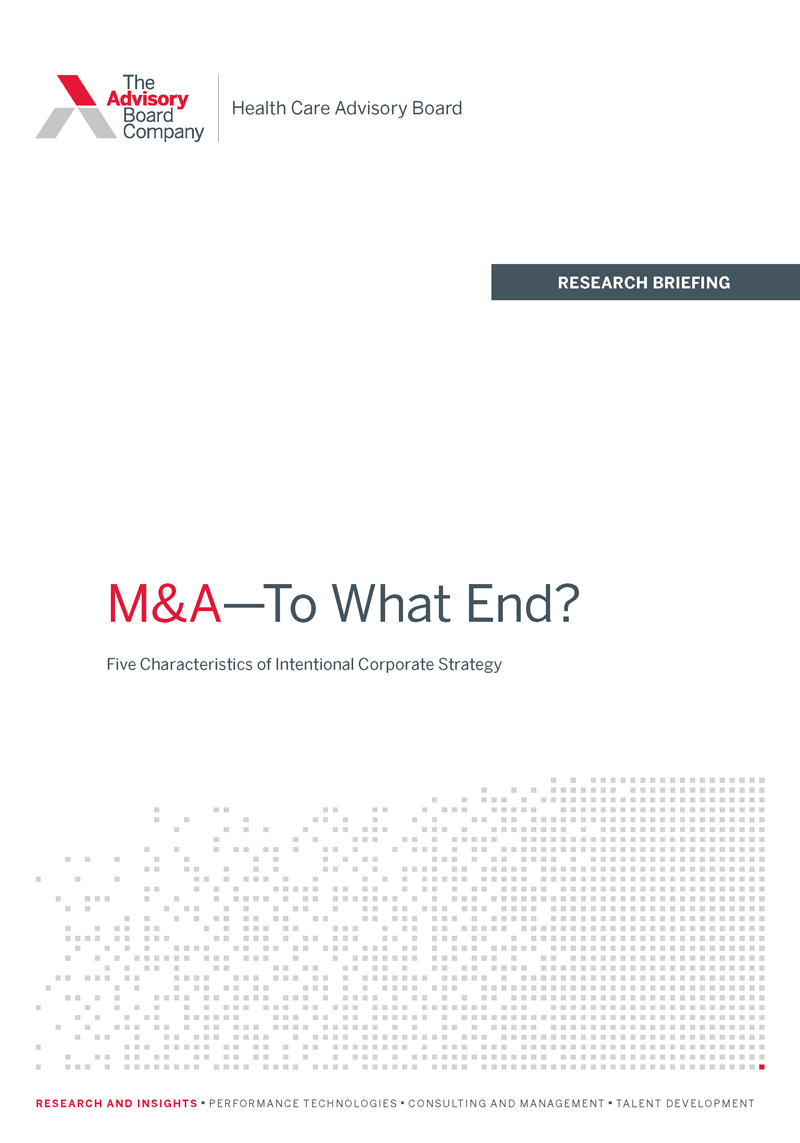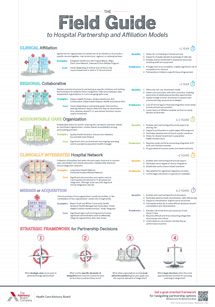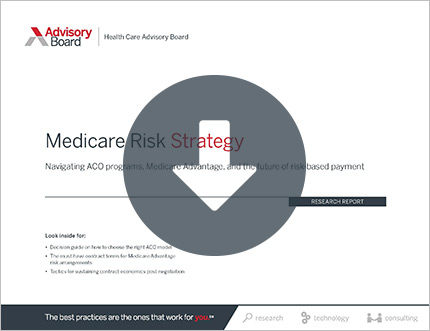Auto logout in seconds.
Continue LogoutWelcome to the "Lessons from the C-suite" series, featuring Managing Partner Eric Larsen's conversations with the most influential leaders in health care.
In this edition, Bob Garrett and John Lloyd, co-CEOs of Hackensack Meridian, talk to Eric and Mike Higgins, Managing Principal, about their unique leadership structure, building a medical school for tomorrow's doctors, and what will headline Hackensack Meridian's press releases for 2022.
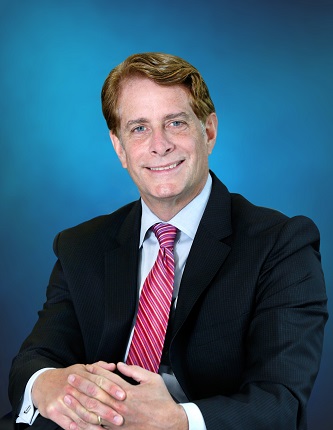
Bob Garrett, Co-CEO, Hackensack Meridian Health
Question: There's been a lot of interest in the Hackensack-Meridian merger—now a $4.5 billion system encompassing thirteen hospitals—for multiple reasons, not least of which is your unique, co-CEO leadership model, as well as how the deal got hatched (at a hotel swim-up bar? More on that later).
I'm excited to delve into all this, but before I do, let's start with a brief retrospective on each of your careers. Pretty exceptional runs for you both, by any measure, and vastly different paths to the C-Suite.
John, let's start with you. After graduating from Princeton, you served as a Marine. Your first CEO assignment was at age 36 at Jersey Shore University Medical Center. When you arrived, the hospital was under scrutiny by the Department of Health, and there was a vote of no confidence in the CEO. Not an auspicious start, I'd say.
John Lloyd: That's true. A rough first assignment. The Jersey Shore team prided themselves on being low-cost, but they had multiple citations and the Department of Health was threatening to shut down nursing units when I arrived. Morale was low. People asked me why I took the job. I said, "I'm a very smart man. I can't make it worse." I didn't see daylight for five years.
We were able to assemble the right leadership, work with the physicians, and start to turn things around. About five years later, we started making money. And we worked really, really hard to improve the bottom line by about $75 million over those five years.
I ran Jersey Shore for 15 years, and then created a health network, Meridian Health, with three other hospitals at the time. Meridian Health eventually grew into a $2 billion system over time. Sometime around that period—it was the late '80s—I started asking myself, "Why are we running hospitals and not putting services in the community?" So over many years, we built this massive continuum of care. Today, it consists of 120 locations in a two-county area. It's one of my proudest accomplishments, working with the entire Meridian team. Two other accomplishments at the top of my list were achieving magnet status and being a six-time recipient of Fortune Magazine's Top 100 Companies to Work For in America.
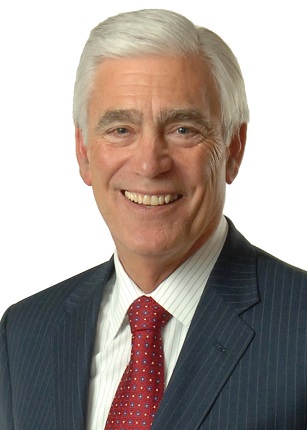
John Lloyd, Co-CEO, Hackensack Meridian Health
Q: Bob, you've had a remarkable run at Hackensack University Medical Center, starting in 1981 as a resident and later becoming president and CEO. It's rare to see that kind of longevity with the same institution. What are some of the high points along your journey?
Bob Garrett: I'm most proud of growing a community hospital into a teaching hospital and ultimately into one of the nation's top academic medical centers (AMC).
I'm also proud of Hackensack's exceptional quality performance, which was recognized early on when we first received the Magnet award for nursing. Later, we were one of the seven original hospitals in the Institute for Healthcare Improvement (IHI) Pursuing Perfection grant. That really changed how we looked at clinical quality in hospitals and put us on our current path.
In recent years we created Hackensack University Health Network, which was recognized as a national leader in health care. My family and I have always looked at the Hackensack community as our second family. My wife Laura worked at the hospital and has engaged in volunteering activities there for many years. My two sons have also worked and volunteered there. It was said to me early in my career that working at Hackensack is not just a job, but a way of life. Nothing has been more true.
Merging complementary assets and cultures
Q: Let's talk about your merger. Can you tell me about the genesis? And I definitely need to know if the story about you two formulating this plan at a hotel resort swim-up bar—while on vacation together—is true.
Lloyd: Yup—all true. You can't make that kind of thing up.
But to take a step back—when the Affordable Care Act took effect, we assembled Meridian's trustees, physicians, and executives together to figure out our path forward. After those discussions, we very deliberately explored partnership opportunities with various health systems, but we weren't comfortable with the cultural fit with everyone we were talking to.
We had just walked away from our second or third potential merger when Bob and I happened to be on vacation together with our wives and two other couples. Bob and I have known each other for more than 25 years. We are friends, and we have deep respect for each other.
On the second day, we're having a few cocktails ...
Garrett: … in the pool.
Lloyd: Go ahead, Bob, describe the visual.
Garrett: Think about John and I in the pool together talking about a merger. And after a couple of cocktails, he says, "Yeah, you know, a merger does sound good, Bob." I just so happened to have the documents on hand ...
In all seriousness, we, too, had done some soul-searching and initiated similar discussions with potential partners after the Affordable Care Act took effect. At a subsequent board retreat, we talked about the need to grow. Those discussions resulted in us forming the Hackensack University Health Network and initiating conversations with potential partners. But just like John and Meridian, we ran into issues of cultural fit.
Q: That's a great origin story. And I think we'll agree, an unprecedented one. Given that you both endured stalled conversations with other organizations, what was it that inspired your confidence in this particular partnership?
Garrett: We felt our organizations were truly complementary. Hackensack was focused on academics, research, innovation, and being a leading clinical player. We were building a network up in northern New Jersey, just outside of New York.
Meridian had made incredible progress in terms of seamless integration; it's not lip service. Many multi-hospital health systems operate as a loose confederation of hospitals. The integrated hospital and ambulatory care network that Meridian built under John's leadership was really amazing. We saw great strength in those two features.
After our first meeting with Meridian, there was a lot of excitement among the trustees and me that Meridian might finally have the partner attributes we had been seeking.
Lloyd: And our trustees felt the same way.
One other thing on why we pulled the trigger. I've always believed in the importance of contiguous geography. Our geography was complementary, so that was another positive factor.
Q: Your co-CEO, shared leadership structure is fairly unusual. How did that come about?
Lloyd: At one point, it was clear that Bob's board wanted him to be the sole CEO and my board wanted me to be the sole CEO. We didn't want the trustees fighting over this, and Bob and I never fought over it.
Garrett: Because each organization had different strengths, we thought the shared governance model would work really well. That means not just co-CEOs, but also co-chairs of the board. Equal representation from both sides.
Q: I heard you had an interesting method of dividing up your duties and focus areas.
Lloyd: We definitely did. We were at dinner one night and I suggested, "Why don't we take a blank piece of paper and each write what we think our respective responsibilities should be. And then let's come back in a week and compare our notes." Remarkably, our lists were a 90 percent match. It's because we have different natural strengths and interests.
Q: So it sounds like the planning stages were surprisingly easy. Let's move on to the hard stuff—actually extracting synergies and savings from the combined entity. At the risk of oversimplification, I'd like to ask your integration thoughts from three perspectives.
The first is consolidating back office functions and eliminating duplicative services. I've heard you both say—separately—that you've already extracted nearly $200 million in cost savings, and that there likely will not be any layoffs.
Lloyd: Yes, that's right.
Q: The second stage of integration, reducing unjustified clinical variation, is a lot more elusive, while the third—asset rationalization (closing or combining physical assets and removing fixed costs)—is even more rarely attained.
Fair characterization of the roadmap? How are you two thinking about charting course here along all three dimensions and measuring success?
Garrett: Yes, I think your characterization is right. And I agree with you that the low-hanging fruit is non-clinical synergies. And that's not to say it's a piece of cake, because it's not. We've identified an additional $300 to $400 million in savings to be captured over the next five years.
We're already seeing better care coordination across the system, not to mention less leakage as well. As an example, our transplant program at Hackensack just opened up an office at Jersey Shore University Medical Center, where transplant patients had been referred to other networks before the merger. Now, the clinicians are starting to see the benefit of keeping patients within network from a clinical perspective, a continuity perspective, and a care variation perspective.
Let me give you another encouraging example. Through our new partnership with Memorial Sloan Kettering Cancer Center (MSK), we are developing standard clinical protocols for how cancer patients will be treated at MSK and throughout our network in New Jersey. That partnership accelerated our cancer care coordination efforts. There were already MSK and Hackensack Meridian teams that had been working together. But because of the partnership, by the end of this year we're going to have coordinated clinical protocols in some of the major cancer service lines. It's an objective that might otherwise have taken years—or even a generation—to accomplish.
Lloyd: At this point, we're coming up on 10 months post-merger, and we've made a lot of progress. We put forth a strategic plan 18 months or so ago, and we've been working hard to implement it.
There are some things that are harder than others. For instance, we knew that IT and electronic records integration would take a while because Hackensack is using Epic, and we are transitioning to that system. But we have a really good plan there, and we're confident we'll be successful.
Geographic consolidation and expansion
Q: New Jersey is one of the fastest-consolidating states in the nation. Over the last 18 months, the four big systems have become two—Hackensack Meridian and RWJBarnabas—each with expansive geographic reach and each with $4 to 5 billion in revenues. And now of course RWJBarnabas combining with Rutgers. How much more consolidation activity do you expect in NJ?
Garrett: My prediction is that there will be more—and different—kinds of partnerships executed in the state, though they won't all be full-asset mergers. Let's face it: Mergers aren't easy. For every one that works, many others fail.
If you think about what you need to achieve in terms of integration and population health, in terms of scale and size and geographic coverage, the super-clinically-integrated networks may be the way to go. We're seeing that in some other parts of the country, and I think you'll start to see that in New Jersey, too.
Q: One-third of the state is now within 15 minutes of a Hackensack Meridian facility. Bob and John, in separate conversations with me you've said the ambition is to raise that ratio to 50% of the state within 10 minutes of one of your facilities. How are you thinking about further geographic expansion?
Lloyd: Right now, we have coverage all the way into New York State, almost all the way down to Atlantic City, and well into mid-state. We're not in a race to cover all of New Jersey. What we're trying to do is grow contiguously and in a way that will work well with our efforts to manage the health of populations.
Q: Let's pivot for a moment from horizontal to vertical integration. How much appetite does HMH have to take on more delegated risk, or potentially move upstream to own the entire premium dollar through a joint venture or provider-sponsored health plan? I understand that both Hackensack and Meridian separately explored various Medicare Advantage partnership options in the past with uneven success. Would love to hear your most recent post-merger thinking on this.
Garrett: Yes, good point—there is some history here. But more broadly, if you look at the track record of provider-sponsored health plans, you can learn a lot about what to do and what not to do.
There's no doubt in my mind that there's good opportunity for growth in Medicare Advantage because of low penetration in New Jersey. It's also instructive to look at the health systems that have had success in developing and running their own health plans. But I think there might be more advantages in a partnership model to mitigate the risk, as well as having at least an initial focus on MA to get your bearings. We've also learned a lot about managing lives with our Medicare Shared Savings Program ACO.
Lloyd: I think Bob said it well: We're more likely to partner or explore other options than start our own plan.
Developing a future generation of physician leaders and fostering a culture of discovery
Q: Bob, one of the joint projects you already have underway is the creation of a new medical school. Would love to hear about the motivation and objectives here, and how things are progressing.
Garrett: We started planning for our own medical school because we felt that it would be a huge strategic differentiator and provide a critical supply of physician talent for generations to come.
We'll co-own the school, which will be the first private medical school in the state, with Seton Hall University. We're leasing 16 acres of land on the former campus of Hoffman-La Roche. Not only is it a great piece of property on one of the busiest roadways in New Jersey, but it also has a great history of discovery and innovation. Valium was discovered there, as were vaccines and anti-AIDS medications.
We're creating an interprofessional education that we think is unique. Seton Hall will relocate their college and their health science schools to the medical school campus, and we'll integrate those schools into the medical school. The vision is to promote greater cross-disciplinary interaction among the 3,000 students, breaking down academic barriers. If we can get the students to work as teams early on, they'll be able to focus on team medicine when they come to work at a hospital or an ambulatory care center and patient outcomes will inevitably improve.
We're hoping to have everything in place to receive preliminary accreditation by January 2018 and welcome the first students on the campus in July 2018.
Q: My understanding is that the campus will also house your clinical research initiatives.
Garrett: Yes, exactly. We're particularly excited about starting a regenerative medicine institute that will be housed on that campus. When you think about the promise of cellular therapies to cure diseases and reverse the aging process, it's absolutely mind-boggling.
We also want to establish ourselves as an innovation leader. We've partnered with the New Jersey Institute of Technology (NJIT) to launch an innovation center, which will have a location on the medical school campus. We're also creating an ideation center to encourage people within and outside of Hackensack Meridian to share their ideas on how to improve health care. The board has approved a $25 million capital fund to invest in start-up companies.
Closing thoughts
Q: I'm going to challenge you both to look a few years into the future. What's the headline of the press release for Hackensack Meridian Health on Jan. 1, 2022?
Garrett: Here are a few:
"Hackensack Meridian graduates its first class at the School of Medicine."
"Hackensack Meridian's regenerative Medicine Institute announces major breakthroughs in curing cancer, diabetes, reversing the aging process."
"Hackensack Meridian's super-clinically-integrated network now covers the entire state of New Jersey and then some with 10,000 providers' or more."
"Hackensack Meridian Health's Innovation Center receiving international accolades and is now partnered with 100th startup company.'"
Q: That's a lot of headlines for 2022.
Lloyd: They're good. And I have to add one more: "John's wife, the nurse, wheels him back in a wheelchair."
Garrett: Oh, yeah—and, "Bob and John go back to Cabo for reunion."
Lloyd: Yeah, there's definitely going be a wet-bar reunion there somewhere.
Get more lessons from the C-suite
Check out our recent must-read interviews with other top hospital and health system leaders:
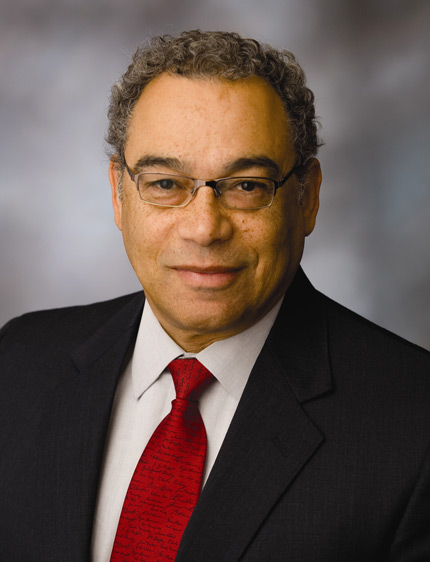 As a soldier, Legacy's CEO witnessed the fall of the Berlin Wall. Here's how George Brown is serving his system now.
As a soldier, Legacy's CEO witnessed the fall of the Berlin Wall. Here's how George Brown is serving his system now.
George Brown, CEO of Legacy Health System, talks to Eric about transitioning into civilian care after years in the military, addressing the social determinants of health, and collaborating with non-traditional partners. Read our interview with George.
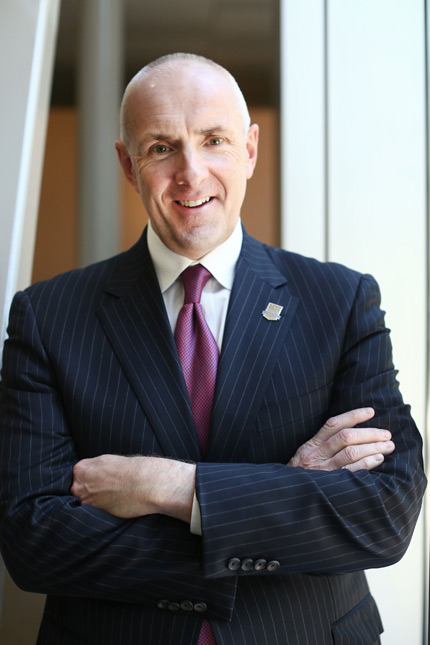 Warner Thomas built a $3B health system in the wake of Hurricane Katrina. Here's how.
Warner Thomas built a $3B health system in the wake of Hurricane Katrina. Here's how.
Warner Thomas, president and CEO of Ochsner Health System, talks about rebuilding a stronger health system after Hurricane Katrina, managing "hypertrophic growth" by focusing on the patient, and the most rewarding part of being a leader.
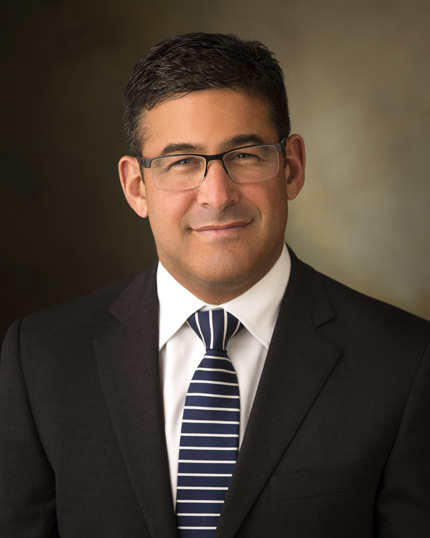 Building the 'Tesla' of health systems: Where Marc Harrison plans to take Intermountain next
Building the 'Tesla' of health systems: Where Marc Harrison plans to take Intermountain next
Marc Harrison, president and CEO of Intermountain Healthcare, talks about crafting a cohesive team with employees from 71 countries, taking Intermountain from a "horseless carriage" to a Tesla, and leading as a physician—and as a patient. Read our interview with Marc.
Don't miss out on the latest Advisory Board insights
Create your free account to access 1 resource, including the latest research and webinars.
Want access without creating an account?
You have 1 free members-only resource remaining this month.
1 free members-only resources remaining
1 free members-only resources remaining
You've reached your limit of free insights
Become a member to access all of Advisory Board's resources, events, and experts
Never miss out on the latest innovative health care content tailored to you.
Benefits include:
You've reached your limit of free insights
Become a member to access all of Advisory Board's resources, events, and experts
Never miss out on the latest innovative health care content tailored to you.
Benefits include:
This content is available through your Curated Research partnership with Advisory Board. Click on ‘view this resource’ to read the full piece
Email ask@advisory.com to learn more
Click on ‘Become a Member’ to learn about the benefits of a Full-Access partnership with Advisory Board
Never miss out on the latest innovative health care content tailored to you.
Benefits Include:
This is for members only. Learn more.
Click on ‘Become a Member’ to learn about the benefits of a Full-Access partnership with Advisory Board
Never miss out on the latest innovative health care content tailored to you.
